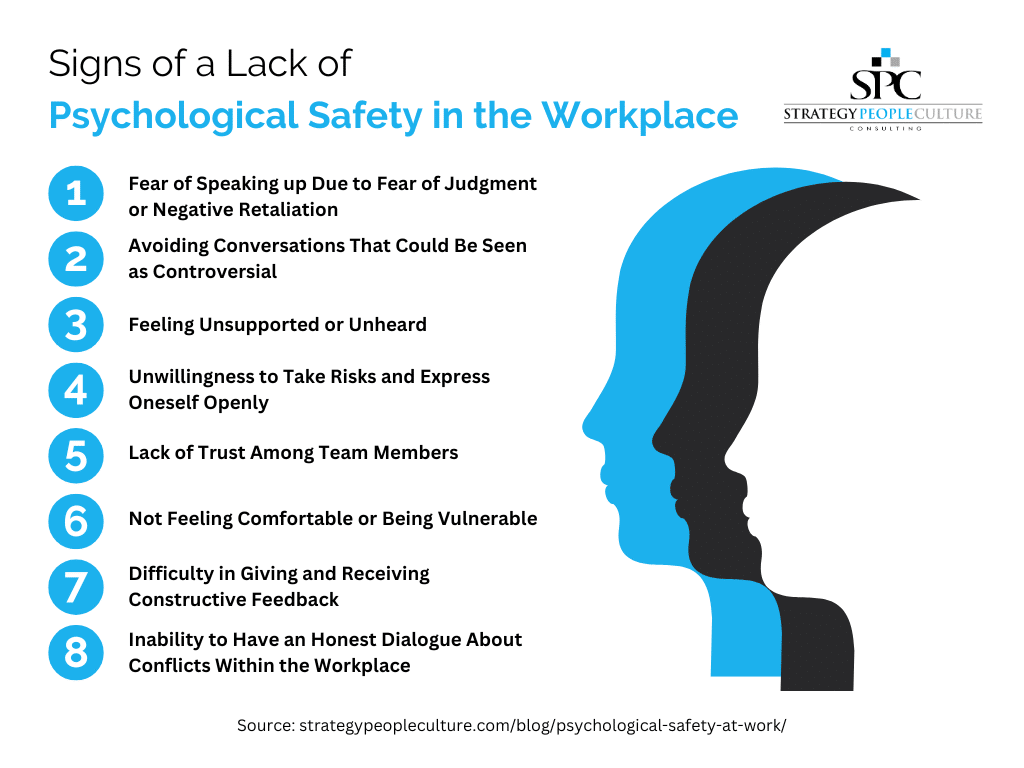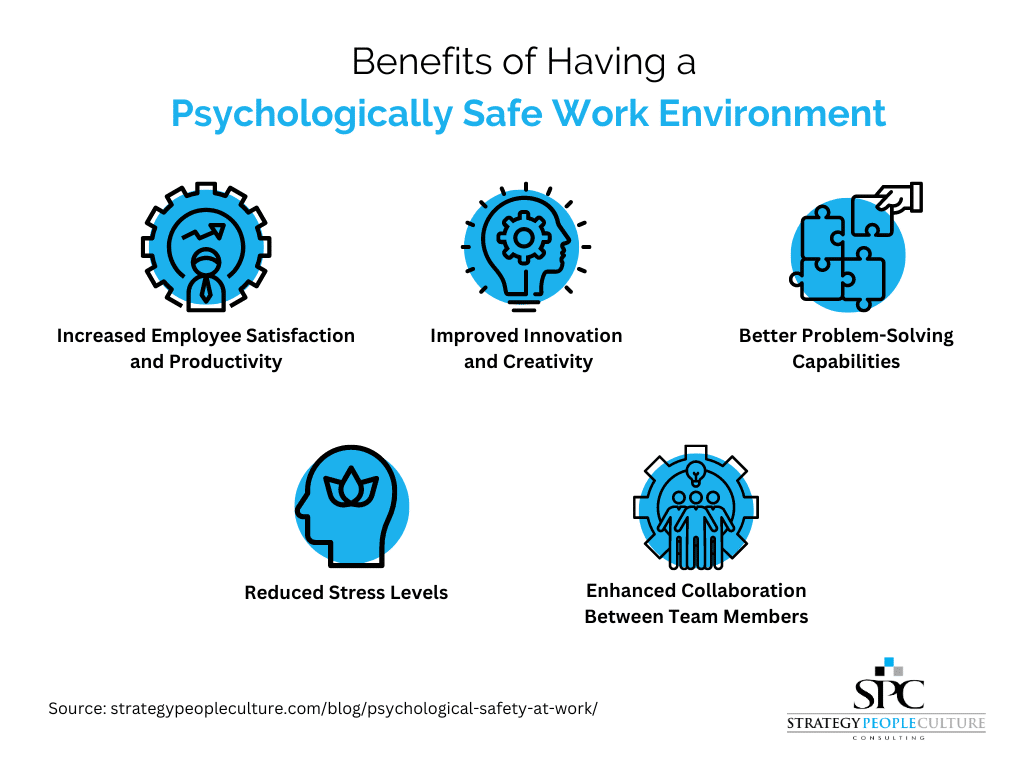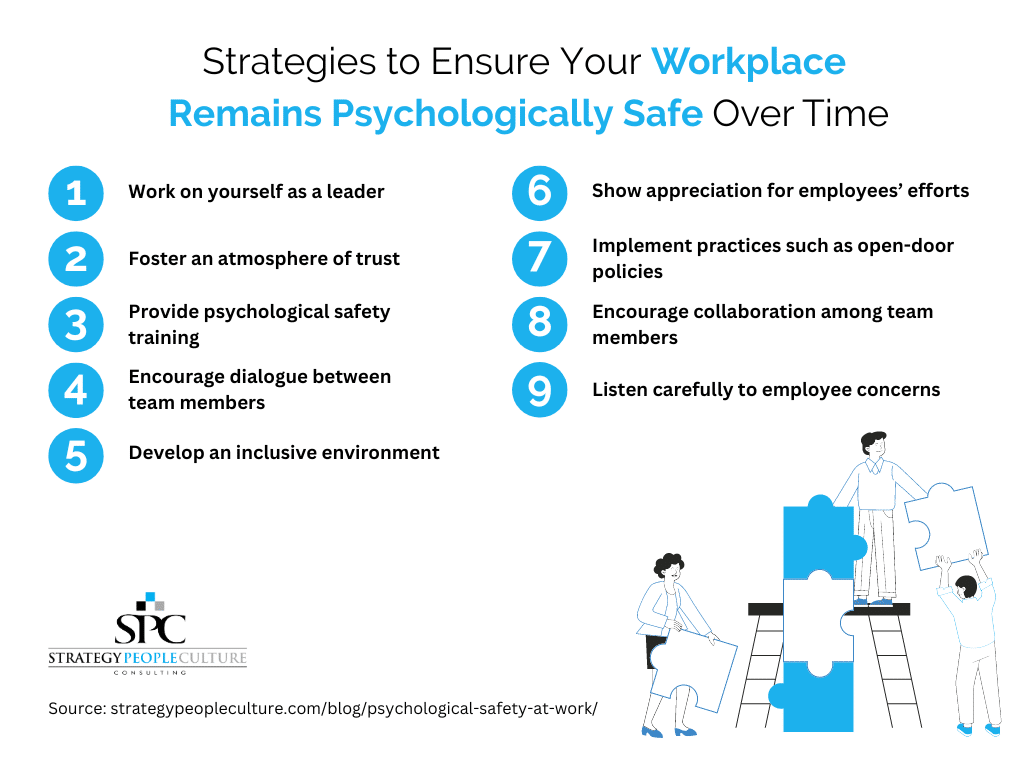How to Establish a Culture of Psychological Safety in the Workplace

Creating a psychologically safe workplace is essential for any successful business. Some leaders may challenge this notion and ask why? Some leaders may even feel the opposite believing their employees perform better when they feel unsafe. If you believe this, skip to the end and call us immediately for help. If you buy into the concept or want to explore and learn more, please read on. Psychological safety encourages employees to express themselves without fear of judgment, fosters open communication, builds an inclusive environment that celebrates different points of view and diversity and makes organizations stronger. This blog will explore how leaders can lead with psychological safety in mind, from establishing trust and providing support to encouraging dialogue between team members.
We’ll also examine the benefits of having a psychologically safe work environment, including improved employee satisfaction and productivity, as well as increased innovation and creativity.
Finally, we’ll look at some strategies for making sure your workplace remains psychologically safe over time. By the end of this blog post, you’ll have a starting framework to assist in elevating a thriving workplace where everyone feels accepted and respected.
What is Psychological Safety?
Psychological safety is a concept that has been gaining traction in recent years, as it has become increasingly clear how important it is for creating healthy and productive work environments. Put simply, psychological safety refers to an atmosphere in which employees feel secure enough to take risks and express themselves without fear of negative repercussions or judgment. It involves the creation of a culture of trust and respect, where team members feel comfortable speaking up and being vulnerable with one another.

Here are some of the signs of a lack of psychological safety in the workplace:
1. Fear of Speaking up Due to Fear of Judgment or Negative Retaliation
Employees may be reluctant to voice their opinions and ideas out of fear that their voice, opinions, and ideas may not be welcomed or could be perceived as challenging the authority of people who can influence their livelihood. Ask yourself, if you feel you can make a positive difference by sharing an alternative perspective or innovative idea, though believe if it is not taken well by your superiors or colleagues and could negatively affect your job status or income, why would you say something? Leaders who don’t embrace psychological safety foster a bias often called the bandwagon effect; in other words, just blindly agreeing with the boss. No one, including the Bill Gates’, Elon Musks’ or Warren Buffets’ of the world, have all the answers, and without input from others, they would undoubtedly have been somewhat less successful.
2. Avoiding Conversations That Could Be Seen as Controversial
Avoiding conversations that could be seen as controversial can lead to a lack of open communication, which can create an atmosphere of uncertainty and mistrust in the workplace. This can hinder employee engagement and collaboration, resulting in low morale, higher turnover, and decreased productivity.
3. Feeling Unsupported or Unheard
Feeling unsupported or unheard in the workplace can lead to employees feeling isolated and disconnected, which can result in reduced motivation, decreased job satisfaction, and increased absenteeism. We believe a fundamental element of human beings is a desire to be or feel valued.
4. Unwillingness to Take Risks and Express Oneself Openly
An unwillingness to take risks and express oneself openly can lead to a lack of creativity, innovation, and problem-solving capabilities in the workplace, resulting in an inefficient and unproductive environment.
5. Lack of Trust Among Team Members
When trust is lacking, communication can be stifled, collaboration may suffer, and employees can end up feeling isolated, unheard, and unsupported. This can lead to decreased job satisfaction and decreased productivity.
6. Not Feeling Comfortable or Being Vulnerable
Vulnerability is critical for building trust, fostering honest feedback, and encouraging the creative collaboration that leads to innovation. The famous author Patrick Lencioni speaks about this as a core reason for team dysfunction in his best-seller, 5 Dysfunctions of a Team. A workplace culture that discourages vulnerability will inevitably suffer from stunted communication, increased stress, and lower job satisfaction.
7. Difficulty in Giving and Receiving Constructive Feedback
A restrictive management approach that discourages feedback and input suffocates progress. When workers are tightly controlled and not empowered to think for themselves, collaboration, creativity, and growth are restricted. When people don’t get feedback on how expectations are being met or missed, how can they know how to improve or meet the organizational goals?
8. Inability to Have an Honest Dialogue About Conflicts Within the Workplace
A failure to openly and honestly address workplace conflicts leads to festering resentment and frustration. When team members cannot have authentic conversations about disagreements and difficulties, collaboration, creativity, and job satisfaction suffer. As a result, team morale and productivity inevitably decline.

Why Learning How to Establish a Culture of Psychological Safety in the Workplace is Vital for Leaders
Leaders are ultimately responsible for the level of success an organization can achieve. Further, leaders play a critical role in creating a psychologically safe work environment; the two concepts are interconnected. It’s the leaders’ responsibility to ensure their team members feel respected and accepted and that they have the resources and support they need to succeed. When team members feel comfortable and appreciated, they’re more likely to contribute new ideas and bring their best possible contributions to the workplace.
A study conducted by Harvard Business School professor Amy Edmondson found that psychological safety is a key factor in successful teams. In her research, she identified four characteristics of teams with high psychological safety: trust among team members, willingness to take risks and voice ideas, understanding of each other’s strengths and weaknesses, and the ability to handle conflicts without negative consequences. This study is consistent with other research in this area.
Benefits of Having a Psychologically Safe Work Environment

Psychological safety has been identified as one of the leading factors in workplace performance and success, with studies showing that a comfortable and inclusive atmosphere can lead to the following benefits:
Increased Employee Satisfaction and Productivity
Employees who feel accepted and respected in their workplace are more likely to be engaged, motivated, and more productive.
Improved Innovation and Creativity
When team members feel safe to express their fear of negative consequences is removed, opening up greater possibilities for innovation, idea sharing, and creative solutions.
Better Problem-Solving Capabilities
By creating an environment where employees can openly communicate their ideas, leaders can make sure that everyone’s best thinking is being utilized when solving complex problems or making decisions that affect the organization.
Reduced Stress Levels
A psychologically safe work environment fosters a culture of trust and respect, which can help reduce stress levels among employees by reducing feelings of anxiety or insecurity. It is not uncommon to hear or read about elevated concerns about employee mental health today; providing a psychologically safe environment is part of the solution!
Enhanced Collaboration Between Team Members
When psychological safety is part of the corporate culture, it encourages open communication between individuals as well as teams – enabling them to collaborate more effectively on projects together for greater success overall for the organization.
Challenges in Establishing a Culture of Psychological Safety

Establishing a culture of psychological safety in the workplace can be a challenge for many employers, as it requires creating an atmosphere of trust and respect.
One of the biggest challenges to establishing a culture of psychological safety in the workplace is resistance to change. People can be resistant to change for many reasons, including fear of the unknown, lack of understanding, or even a feeling that things are going well enough (as distinguished from having elevated success) as they are. It’s important for leaders to recognize this resistance and be willing to challenge themselves (e.g., through an executive coach) and have conversations with those who are hesitant about a new approach, making sure to listen to their concerns and address them in a supportive way.
Another challenge is the lack of resources or knowledge on how to implement psychological safety initiatives. Leaders must ensure they are well-versed in this area, as it requires both understanding of the concept and the ability to effectively communicate it to their team members. It’s important for them to be aware of the different strategies that can help create a psychologically safe workplace, such as empowering employees to take measured risks, such as sharing different ideas without fear of judgment, providing psychological safety training for supervisors, and fostering dialogue between team members.
It is also important to recognize that no two employees have the same level of comfort when it comes to discussing sensitive topics – so leaders should be aware that different people may require different levels of support during conversations.
Keep in mind there is always the risk of backlash from other team members if someone speaks out against popular opinion – so it’s important for leaders to create an environment where all opinions are welcome and develop a way for the thoughts to be shared and heard constructively.
Finally, employers must also stay mindful of the fact that psychological safety is an ongoing process. It requires continued effort and attention to ensure it remains part of the workplace culture. This includes regularly checking in with employees, providing support when needed, and making sure everyone understands that their ideas and perspectives are valued.
Strategies to Ensure Your Workplace Remains Psychologically Safe Over Time

Creating and maintaining a psychologically safe workplace is essential for any successful business. It encourages employees to express themselves, fosters open communication, and builds an inclusive environment that celebrates diversity of thought. To ensure your workplace remains psychologically safe over time, there are some key strategies leaders should follow. These include:
- Work on yourself as a leader and get an objective challenge partner such as an executive leadership coach. There is a reason why they tell you in case of an emergency on a plane to put an oxygen mask on yourself before helping others, and it is no different here.
- Foster an atmosphere of trust by promoting honest communication and feedback. This means creating an environment where employees feel comfortable speaking up without fear of judgment or retribution.
- Provide psychological safety training for both supervisors and employees to ensure that everyone has a clear understanding of the importance of psychological safety in the workplace.
- Encourage dialogue between team members so employees can have meaningful conversations about issues, ideas, and challenges in a constructive and receptive environment.
- Develop an inclusive environment where everyone feels accepted and respected regardless of their background, race, gender identity, etc.
- Show appreciation for employees’ efforts and recognize their accomplishments to boost morale and motivate them to continue striving for excellence.
- Implement practices such as open-door policies that encourage employees to speak up if something is wrong or if they feel uncomfortable with a situation at work without fear of repercussions from management or colleagues alike.
- Encourage collaboration among team members so problems can be solved collectively rather than individually, which leads to greater success overall for the organization as a whole.
- Listen carefully to employee concerns when something arises so you can address them quickly before it becomes an issue.
Be proactive instead of reactive in addressing potential conflict situations.
By implementing these effective strategies, employers can create a thriving work culture where everyone feels accepted and respected.
6 Skills Leaders Need to Develop and Maintain Psychological Safety in the Workplace

To create this environment, leaders must develop certain skills and take specific actions:
1. Active listening
Leaders should practice active listening by giving employees their full attention, maintaining eye contact, nodding along or saying “uh-huh” periodically to show understanding, paraphrasing what the speaker says to confirm comprehension before responding. This shows employees that their voices are heard and valued.
2. Open Communication
Leaders should foster open communication by creating opportunities for honest dialogue between team members where everyone feels comfortable sharing their constructive thoughts without fear of judgment or it being held against them. They can do this through regular meetings, feedback sessions, suggestion boxes, etc.
3. Empathy
Leaders need empathy in order to show their understanding of how employees may feel in different situations and what they need to feel supported. Showing empathy allows leaders to better address concerns or conflicts that arise, as well as determine appropriate ways of handling them.
4. Trustworthiness
For psychological safety to exist, there must be a sense of trust between leaders and employees. Leaders build trustworthiness through integrity (following through on promises), reliability (being consistent), and competence (having the skills/knowledge to lead effectively).
Inclusiveness: Leaders should promote inclusiveness by valuing diversity and ensuring that people from all backgrounds feel like their perspectives are welcomed. This means avoiding biases or stereotypes and giving equal opportunities for growth/development regardless of gender, ethnicity, sexual orientation, etc.
5. Recognition
Providing recognition shows employees their efforts are appreciated, which boosts morale and motivation. Leaders can recognize good work through verbal praise, spot bonuses, or other rewards. Even small acts of recognition go a long way toward building psychological safety.
6. Continuous Effort
Finally, leaders should commit to continuously working to sustain a culture of psychological safety. This means regularly checking in with employees, addressing any issues that arise promptly and sensitively, reviewing practices/policies for inclusiveness, and reaffirming the importance of open communication and honest feedback. Psychological safety requires ongoing work to maintain.
How Team Members Can Contribute to Building a Culture of Psychological Safety in the Workplace

To cultivate a work environment of psychological safety, team members should:
Speak With Candor
Share thoughts and ideas openly without fear of reprisal or judgment. Welcoming questions and discussion show that input is valued.
Acknowledge Mistakes and Limitations
Admitting what one doesn’t know or when errors occur, models that imperfection is acceptable. This vulnerability builds trust and encourages others to do the same.
Share Credit and Celebrate Wins
Whether individually or as a team, recognizing the efforts and achievements of others promotes a sense of value and inclusion. Spread praise and credit wisely.
Practice Active Listening
Paying full attention to colleagues and being receptive to their needs and perspectives helps people feel seen and heard. This fosters open communication and collaboration.
Offer Support
Cheering on team members and providing encouragement or resources as needed lets others know they are not alone. A strong support system is key to a psychologically safe space.
With a straightforward yet confident tone, team members can cultivate psychological safety by speaking openly, admitting imperfections, sharing credit, practicing active listening, and offering support. A work environment where people feel comfortable taking risks and being vulnerable leads to greater creativity, innovation, and productivity. Fostering psychological safety is worth the effort.
Conclusion
Creating a psychologically safe work environment is essential for any successful business. It requires ongoing effort to ensure that it remains part of the corporate culture and is not taken for granted. If you’re struggling to create such an atmosphere, consider getting help from an executive coach who can provide insight into how best to foster trust and respect among team members while encouraging open communication between them. Andy Botwin has extensive experience in this area and offers consultation sessions where he will discuss strategies on how leaders can lead with psychological safety in mind.
So don’t hesitate – take action today! Call Strategy People Culture today at 833-762-5772 or email info@strategypeopleculture.com. You can also schedule your free consultation with our team online!
